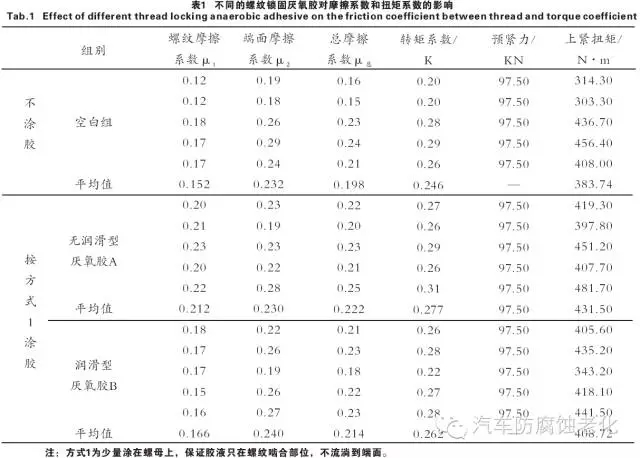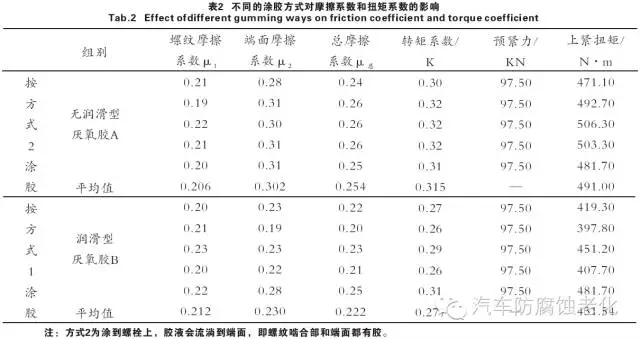Abstract: The thread friction coefficient and torque coefficient of fasteners assembled with thread-locking anaerobic adhesives are tested and analyzed. The results show that the thread friction coefficient of fasteners after thread-locking anaerobic adhesive is tightened. Both the torque coefficient and the torque coefficient will rise to different degrees. The unlubricated thread-locking anaerobic adhesive has a large increase, and the lubricated thread-locking anaerobic adhesive is small; however, the dispersion of the thread friction coefficient and the torque coefficient is greatly reduced.
The torque control method is simple and easy to operate and is one of the most common and extensive fastener tightening methods. The method involves an important parameter, the torque coefficient K, which represents the ratio of the axial force to the tightening torque, and this parameter is related to the friction coefficient of the fastener thread. These two parameters are the reliability of the torque control method. Important indicators. Thread-locking anaerobic adhesive has been used as a chemical anti-loosening method for more than 60 years. Its reliable anti-loose effect has been widely recognized by all walks of life, but the research on the effect of anaerobic adhesive on fastener tightening process less. In this paper, the factors affecting the thread friction coefficient and torque coefficient of fasteners assembled with thread-locking anaerobic adhesives are studied, which provides a reference for the tightening process using torque control method.1 experimental part
1.1 main raw materials and instruments
Non-lubricated thread lock anaerobic adhesive A, lubricated thread lock anaerobic adhesive B, homemade.
10. 9 grade M16X70 galvanized zinc coarse standard bolt and 10 grade zinc plating standard matching nut, commercially available; fastener analysis test machine, ZWICK, Germany.
1.2 Test methods and data processing
After applying the glue on the fasteners in accordance with the prescribed method, test according to the national standard GB/T 3098. 9-2002 and record the friction coefficient of the thread pair μ1, the friction coefficient of the support end face μ2, the total friction coefficient μ total, and the axial regulation The tightening torque T when the tightening force is 97.5 kN.
The fastener torque coefficient K, K = T / (Fd), the pre-tightening torque T when the axial pre-tightening force reaches 97.5 kN, d is the nominal diameter of the bolt.
The fastener torque factor K average is the arithmetic mean of the five sample fastener torque coefficients K.
The average value of the thread friction coefficient is the arithmetic mean of the friction coefficient of the five sample threads.
The thread friction coefficient dispersion is the standard deviation of the friction coefficient of the five sample threads.
The fastener torque coefficient dispersion is the standard deviation of the five sample torque coefficients.
2. Results and discussion
2.1 Influence of different thread locking anaerobic adhesive on friction coefficient and torque coefficient
2.1.1 Effect of non-lubricated thread locking anaerobic adhesive on friction coefficient and torque coefficient
The experimental results show that when the bolts are assembled with unlubricated thread-locking anaerobic adhesive, the average value of the friction coefficient of the thread pair and the average value of the torque coefficient will increase with respect to the uncoated bolts. See Table 1 for details. This may be because the viscosity of the monomer or resin in the thread-locking anaerobic adhesive is large, the screw friction coefficient is increased, the proportion of the axial force is reduced in the tightening torque, and the torque coefficient is increased.
2.1.2 Effect of Lubricated Thread Locking Anaerobic Adhesive on Friction Coefficient and Torque Coefficient
When using a lubricated thread-locking anaerobic adhesive assembly, the coefficient of friction and torque factor of the thread pair are reduced relative to the use of a non-lubricated thread-locking anaerobic adhesive, see Table 1. This is because a certain proportion of lubricant is added to the formulation, so the coefficient of friction and torque factor are reduced.
2.1.3 Effect of coating method on friction coefficient
Experiments show that when the bolt support surface is also coated with anaerobic adhesive or anaerobic glue flowing onto the support surface, the friction coefficient of the support surface is also affected, and the influence trend is consistent with the trend of the anaerobic adhesive on the thread friction coefficient. And further aggravate the impact on the torque factor, as shown in Table 2. Taking the unlubricated thread lock glue A as an example, the friction coefficient of the thread will increase, the friction coefficient of the support surface will also increase, and the torque coefficient will further increase; if it is changed to the lubrication type thread lock glue B, the thread The coefficient of friction will be smaller, the friction coefficient of the support surface will also become smaller, and the torque coefficient will be further reduced.
It can be seen from T = KFd that the impact of anaerobic adhesive on the torque coefficient must be considered when assembling tightly, otherwise the bolt overload or untightening problem may occur. Specifically, according to the influence of the lubricity of the selected anaerobic adhesive on the torque coefficient, the preset pre-tightening torque is corrected in proportion to control the axial pre-tightening force within a reasonable controllable range.


2.2 Thread-locking anaerobic adhesive on the discreteness of the friction coefficient and torque coefficient of the thread
Thread-locking anaerobic adhesive can improve the dispersion of both the friction coefficient and the torque coefficient of the thread, making the thread friction coefficient and torque coefficient more uniform and stable. Through the comparison test, the screw friction coefficient and the K value were tested under the conditions of rubber coating and non-gluing, and the respective standard deviations were calculated. The results are shown in Table 3. Taking the rubber-free anaerobic adhesive A according to the method 1 as an example, after applying the thread-locking anaerobic adhesive A, the standard deviation of the screw friction coefficient is reduced from 0.026 to 0.012, and the drop is 53.8%; the standard deviation of the torque coefficient is 0.041. Dropped to 0.020, a drop of 51.2%. In addition, there is a similar phenomenon in the case of applying the non-lubricated anaerobic adhesive A according to the method 2 and the anaerobic adhesive B for the lubricating method according to the mode 1. This shows that the anaerobic adhesive assembly can make the friction coefficient and torque coefficient of the thread more stable. The coefficient of friction of the threads and the uniformity and stability of the torque factor will greatly reduce the risk of overload and unclamping during bolt tightening, making the torque control method more reliable.

3 Conclusion
1) When the bolt is assembled with unlubricated thread-locking anaerobic adhesive, the average value of the friction coefficient of the thread and the average value of the torque coefficient will increase relative to the uncoated bolt; the lubrication type thread lock anaerobic adhesive When assembled, the coefficient of friction and the torque coefficient of the thread are reduced relative to the use of a non-lubricated thread-locking anaerobic adhesive, that is, the lubrication type thread-locking anaerobic adhesive has a relatively small influence on the friction coefficient and torque coefficient of the thread pair.
2) When the assembly is tightened, the influence of the lubricity of the selected anaerobic adhesive on the torque coefficient should be corrected according to the proportional pre-tightening torque to control the axial pre-tightening force within a reasonable controllable range.
3) Thread-locking anaerobic adhesive can improve the dispersion of both the friction coefficient and the torque coefficient of the thread, making the thread friction coefficient and torque coefficient more uniform and stable.
Ai Shaohua Ai Yanhua Hubei Huitian New Materials Co., Ltd., Fuyang 441041, China;
Zhao Jing Zuo Han Shengli Qinghai Nonferrous Metal Geological Testing Center Xining 810007, ChinaKey words: anaerobic adhesive; thread locking; fastener; torque coefficient; friction coefficient
The xunda Heat Shrinkable Pipe Coating designed for corrosion protection of straight pipes, fittings, bends, elbows and other irregular configurations. It consists low pre-heat modified bitumen sealant adhesive and thick-wall irradiated cross linked polyolefin. When heated the backing layer shrinks and the adhesive flows and forms a reliable corrosion protection seal onto metal and adjacent coating surfaces.
Heat Shrinkable Pipe Coating
Heat Shrink Tape,Heat Shrinkable Pipe Coating,Heat Shrinking Tape ,Heat Shrinkable Sleeve
Jining xunda pipe coating materials co., ltd. , https://www.pipeanticorrosion.com